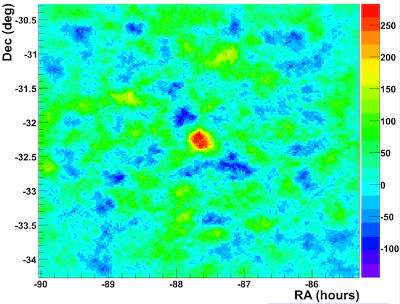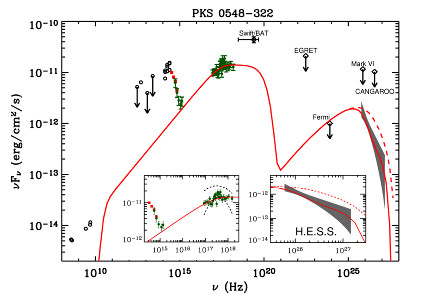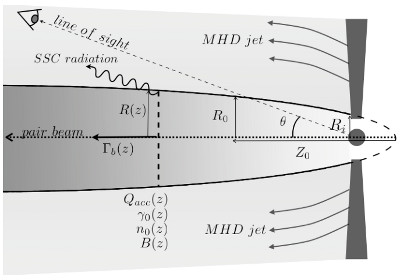HESS discovers gamma rays from the Active Galaxy PKS 0548-322
June 2010

PKS 0548−322 is a nearby and bright BL Lac object, located at a distance of one thousand million light-years (or at a redshift of z=0.068), in the direction of the constellation Columba. The active nucleus is hosted by a giant elliptical galaxy, which is the dominant member of a rich cluster of galaxies. It is the third of such objects detected by the HEAO X-ray satellite in the '70s, and its complex spectral X-ray behaviour has since prompted extensive studies by different X-ray experiments. The X-rays are usually thought to be the signature of extremely energetic electrons interacting with the ambient magnetic fields. But such energetic electrons can also lose energy in a collision with ambient lower energy photons, boosting these to the highest energies and therefore making such X-ray bright sources good targets to search for gamma-rays with ground-based Cherenkov detectors in general and H.E.S.S. in particular.
The first observations of PKS 0548-322 with the previous generation of Cherenkov telescopes in the Southern hemisphere, the British Mark VI and the Australo-Japanese CANGAROO experiments, both based in Australia, were not sensitive enough to detect this source in observations taken at the turn of the century. This provided upper limits to the flux of gamma-rays emitted at energies in the H.E.S.S. energy range, represented in Figure 1. At gamma-ray energies three orders of magnitude lower, the former space-based detector EGRET also failed to detect this source.
It finally took 35 hours of good quality H.E.S.S. data, the most sensitive Cherenkov telescope in the Southern hemisphere, to provide the first detection of PKS 0548-322 which turns out to be so faint that only one gamma-ray is seen every 10 minutes. Even more surprisingly, its lower energy gamma-ray emission still escapes Fermi, EGRET's successor, despite the fact that it has seen almost all active galaxies seen by all the ground-based Cherenkov telescopes.
Contemporaneous observations in the optical with the ATOM telescope at the H.E.S.S. site, X-ray and ultraviolet observaitons with Swift/XRT and Swift/UVOT, as well as more archival data, give an overall picture of its electromagnetic emission over 18 orders of magnitude in energy (Fig. 1), exhibiting a well-known double-humped structure. The first peak is located in the radio to X-ray regime whereas the second is at very-high energies where H.E.S.S. observation take place. The SED is can be explained by different types of models where one of the most popular models - the synchrotron self-Compton model or SSC model – the 10 parameters of which are constrained by the observations, is shown in Figure 1 by the red line. If this source remains undetected by Fermi much longer, this will pose a challenge to current models of the high-energy emission of active galaxies, whereas its detection by Fermi would even further constrain the emission model. Such models (Fig. 2) require a highly relativistic motion of the source, but that is at odds with other facts, namely the relatively numerous objects detected by TeV telescopes and the detection of misdirected jets from radio galaxies, with a higher flux than what is expected from simple beaming models. Although PKS 0548-322 is not in itself particularly constraining the models, due to its relatively low flux and limited statistics, its detection increases the sample of detected objects, and reinforces the needs for a better understanding of the extreme physics at work in these sources.
Reference: Discovery of VHE gamma-rays from the BL Lac object PKS 0548-322", H.E.S.S. collaboration, F. Aharonian et al.

